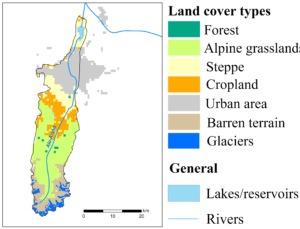
The Ala-Archa Observatory is run by the Central Asian Institute for Applied Geosciences (CAIAG). It is located on the northern slope of the Kyrgyz Ala-Too range and is a part of the larger basin of the Chu River. The Observatory extends from the glacierized headwaters to the agricultural land and the capital city of Bishkek. The region strongly depends on snow and glacier melt for water provision and it is for this reason that the Ala-Archa Observatory has always focused on the monitoring of climate, streamflow, snow cover, and glacier mass balance. There are three meteorological stations and a streamflow gauge operated by the National Hydrometeorological Service of Kyrgyzstan and a high-elevation automatic weather station (AWS) operated by CAIAG.
There are 48 glaciers within the Observatory’s domain. In 1964, their combined area was 40.5 ± 0.5 км2 but by 2010, it had declined to 33.3 ± 0.8 км2 (Bolch, 2015). Glacier mass balance is monitored at the Golubin Glacier, one of the reference glaciers of the World Glacier Monitoring Service (WGMS). A continuous record of glacier mass balance is available for 1969-1994. The monitoring was interrupted following the collapse of the Soviet Union but restored in 2010 by the collaborative efforts of CAIAG, the German Research Centre for Geosciences (GFZ), the University of Fribourg, and the National Hydrometeorological Service of Kyrgyzstan (Azisov et al., 2022). The Observatory assesses risks of extreme events including floods, landslides, and debris flows. In 2019, the Observatory started monitoring hydrochemistry and water stable isotopes in precipitation (Saidaliyeva et al., 2023), streamflow and the components of the cryosphere.
The observatory supplies data for the validation and calibration of hydrological (He et al., 2020) and glaciological (e.g. Barandun et al., 2018) models, and remote sensing products.

